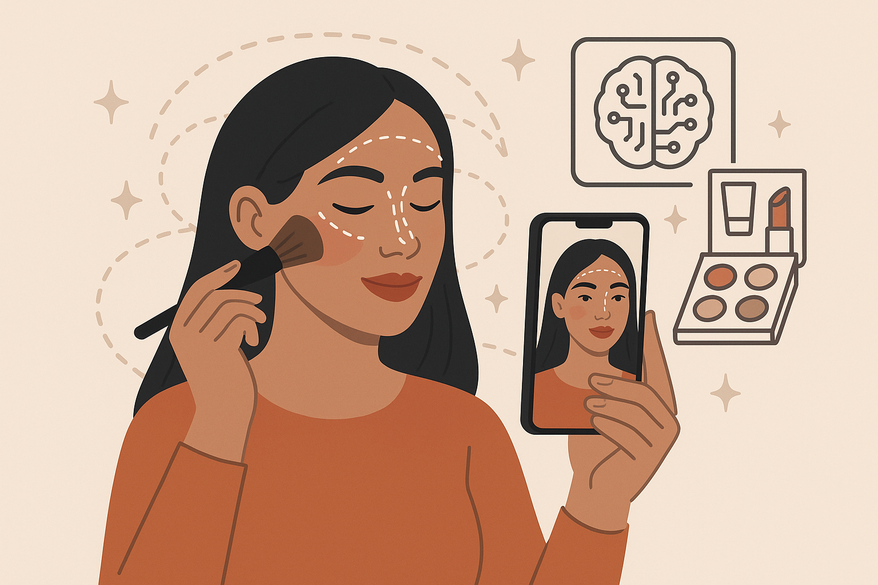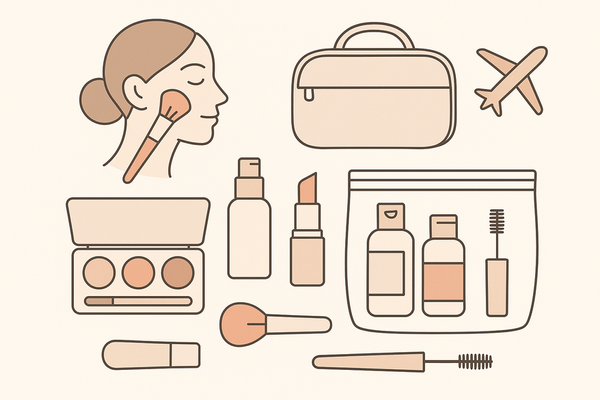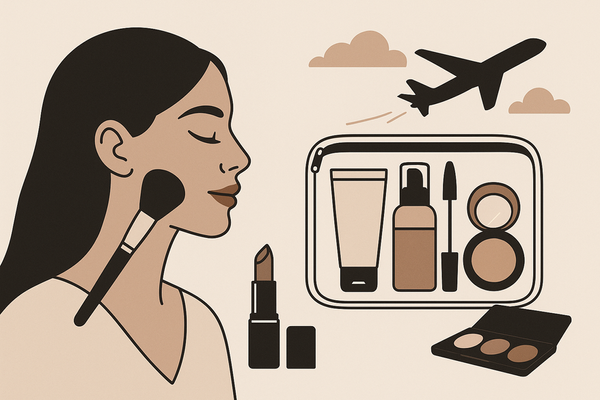Personalized AI Makeup Overlay: Definition, How It Works & Key Benefits
Discover how personalized AI makeup overlays are transforming beauty with real-time customization and AR technology, offering tailored, sustainable solutions.

Estimated reading time: 10 minutes
Key Takeaways
- Understanding what a personalized AI makeup overlay is and how it adapts to facial features
- Step-by-step process: from facial scanning to AR-driven overlay generation
- Main benefits: enhanced personalization, time and cost savings, sustainability, inclusivity
- Common applications: virtual try-ons, remote consultations, interactive tutorials
- Key challenges: technical limits, privacy concerns, device accessibility
Table of Contents
- Introduction
- What Is a Personalized AI Makeup Overlay?
- How It Works
- Benefits of Personalized AI Makeup Overlays
- Applications of Personalized AI Makeup Overlay
- Challenges & Considerations
- Conclusion
- FAQ
In 2024, beauty and technology collide like never before. Powered by the rise of artificial intelligence (AI) and augmented reality (AR), cosmetics have gone digital. Today’s star innovation is the personalized AI makeup overlay—an advanced tool that uses AI + AR to place custom cosmetic effects on your face in real time. Brands and consumers alike use this technology to craft looks that fit each person perfectly. Learn more about virtual makeup try-on.
Why it matters:
- Shoppers can test lipstick shades without messy samples.
- Makeup artists can show clients digital mockups before the first stroke.
- Consumers get personalized makeup solutions powered by AI, saving time, money, and waste.
This post will:
- Define personalized AI makeup overlay.
- Explain how it works, step by step.
- Highlight key benefits.
- Explore real-world applications.
- Note challenges and what to watch for.
By the end, you’ll see how personalized makeup solutions powered by AI are changing beauty routines for everyone.
What Is a Personalized AI Makeup Overlay?
Definition
A personalized AI makeup overlay is a real-time or photo-based digital layer of cosmetics generated by AI. It adjusts to your facial contours, picks shades that match your skin tone, and respects your unique features.
Key Components
- Facial Landmarks Detection: AI spots eyes, lips, brows, cheekbones.
- Skin Analysis: It reads tone, undertone, and texture.
- Color Matching & Style: Shades and finishes adapt to your style.
Core Technologies
- Deep Learning: Models learn from millions of faces.
- Computer Vision: Cameras feed data about your face in real time.
- Semantic Segmentation: Tools like U-Net and Mask R-CNN carve out facial regions for precise makeup placement.
Experience Example
Imagine opening an app, pointing your camera at your face, and seeing a lipstick shade that matches your outfit lighting and mood—all in under a second.
How It Works
AI Algorithms & Machine Learning
- Convolutional Neural Networks (CNNs): Analyze every pixel to detect undertones and blemishes.
- Facial Landmark Tracking: Leverages 20–100 points to follow eye corners, lip edges, and jawline in real time.
- Machine Learning in Action: Models train on diverse skin types, ethnicities, and lighting conditions. Feedback loops refine accuracy as users accept or reject suggestions (see also integrating AI makeup routine).
Tools like Makeup Check AI demonstrate how AI-driven overlays can not only suggest shades but also generate complete virtual looks in real time.
Step-by-Step Creation Process
- Facial Scan: User uploads a selfie or uses live video. System checks structure, lighting, and image quality.
- Feature Mapping: AI segments lips, eyes, cheeks using semantic segmentation. Tools like Mask R-CNN map each facial region precisely.
- Personalization Engine: Shades, finishes, and brush strokes match skin profile and preferences. AI suggests bold, natural, or glam looks based on user input.
- Overlay Generation: AR frameworks like ARKit or ARCore superimpose makeup in real time. Dynamic tracking keeps makeup aligned as you move.
- User Interaction: Adjust intensity, swap products, save looks, or share directly to social media. Feedback trains the model for next use.
Data Input & Model Refinement
- High-quality images: Good lighting and clear resolution deliver best results.
- Feedback loop: Every saved or discarded look feeds back to training data.
- Model updates: Companies push periodic updates to handle new trends or products.
Benefits of Personalized AI Makeup Overlays
Personalization & Confidence
- Tailored suggestions boost self-esteem.
- Users feel seen and understood by technology.
Time & Cost Savings
- No more wasted testers or trial purchases.
- Instant feedback speeds up beauty routines.
Sustainability
- Virtual sampling reduces product waste and excess packaging.
- Brands cut carbon footprint by moving trials online.
Inclusivity
- Supports dozens of skin tones, undertones, and face shapes.
- AI models trained on diverse data prevent bias.
Accessibility & Hygiene
- No physical contact needed—perfect for remote consultations.
- Works on any smartphone or tablet with a camera.
Enhanced Engagement
- Users spend more time in apps trying looks.
- Retailers see higher conversion rates and fewer returns.
Applications of Personalized AI Makeup Overlay
Consumer Virtual Try-Ons
Apps like L’Oréal ModiFace let you test dozens of lip and eye looks in seconds. YouCam and Burberry Beauty Studio power online previews for shoppers.
Remote Beauty Consultations
Professionals give data-driven advice over video calls. Customers show their face and see live recommendations.
E-Commerce Integration
Overlays embed in shopping carts for easy selection and checkout. Brands reduce returns by showing true-to-life previews.
Interactive Tutorials
AR-guided brush strokes teach users where and how much to apply. Step-by-step overlays for foundation, contour, and highlight.
Future Horizons
- 3D holographic try-ons in stores or at home.
- Mood and event-based style suggestions.
- Deep integration with livestream shopping and VR retail.
Challenges & Considerations
Technical Limitations
- Performance can falter under poor lighting or occlusion.
- Extreme facial expressions or props (glasses, masks) may confuse the model.
Privacy & Data Security
- Biometric data needs encryption and strict access controls.
- Clear policies and user consent are vital for trust.
Accessibility Gaps
- Not all devices handle AR equally; low-end phones may lag.
- High-speed internet is needed for seamless streaming.
- Some regions face cost barriers for advanced hardware.
Areas for Improvement
- Expand training data to include more diverse faces.
- Optimize models for lower-power devices.
- Strengthen privacy frameworks to meet global standards.
Conclusion
Personalized AI makeup overlays merge AI, AR, and beauty into one powerful tool. They let anyone:
- Try new looks in real time.
- Save time, money, and the planet.
- Enjoy inclusive and hygienic makeup experiences.
From facial landmark mapping to deep learning and semantic segmentation, this technology offers a level of accuracy and customization once thought impossible. Whether you’re a brand, a pro artist, or a beauty lover, personalized AI makeup overlays hold the key to smarter, more engaging routines.
FAQ
- What devices support personalized AI makeup overlays?
A majority of modern smartphones and tablets with a front-facing camera can run AR frameworks like ARKit or ARCore to support virtual makeup overlays. - How accurate are the shade recommendations?
Accuracy depends on camera quality and lighting, but advanced AI models trained on diverse datasets can match shades within a 5% tolerance for most skin tones. - Is my facial data secure?
Reputable platforms encrypt biometric data and require explicit user consent. Always review a service’s privacy policy before use. - Can I save and share my virtual looks?
Yes. Most apps allow you to adjust intensity, save favorite looks, and share images or videos directly to social media.




